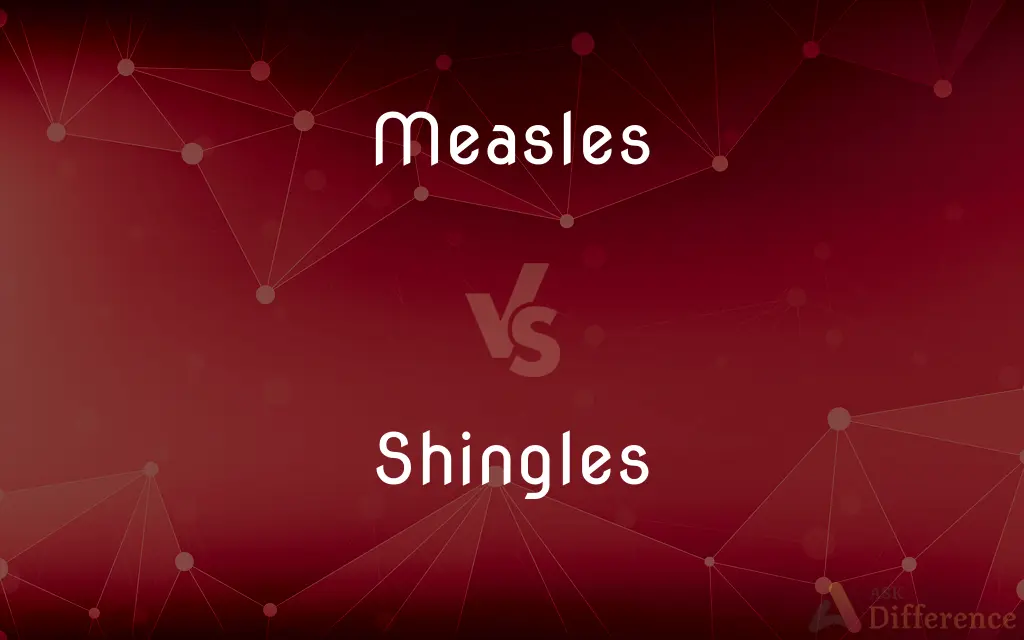Measles vs. Shingles — What's the Difference?
By Maham Liaqat & Fiza Rafique — Updated on March 3, 2024
Measles is a highly contagious viral infection known for its rash and fever, while shingles is caused by the reactivation of the chickenpox virus, leading to a painful rash.

Difference Between Measles and Shingles
Table of Contents
ADVERTISEMENT
Key Differences
Measles, caused by the measles virus, primarily affects children and is marked by symptoms such as fever, cough, runny nose, and a characteristic red rash. It spreads through respiratory droplets and is highly contagious among those not vaccinated. Shingles, on the other hand, occurs when the varicella-zoster virus, which causes chickenpox, reactivates later in life. It leads to a painful rash, usually localized to one side of the body or face, and can affect adults who have previously had chickenpox, especially those with weakened immune systems.
While measles can be prevented through vaccination (the MMR vaccine), there is no cure once infected, and treatment focuses on relieving symptoms and preventing complications. Shingles, although also not curable once the rash appears, can be managed with antiviral medication if administered early, and a vaccine is available to reduce the risk of developing shingles and its complications.
Measles rash is generalized and spreads over the body, while the shingles rash is more localized and often wraps around one side of the torso or face. The measles rash typically appears around 14 days after exposure to the virus and after several days of high fever, whereas the shingles rash develops as a band of blisters following pain, itching, or tingling in the affected area.
Complications from measles can be severe and include pneumonia, encephalitis, and death, particularly in children under five and adults over 30. Shingles complications can involve postherpetic neuralgia, where severe pain persists long after the rash has cleared, along with possible vision or hearing problems if the rash affects the face.
Both diseases underscore the importance of vaccination for prevention. The MMR vaccine protects against measles, and the shingles vaccine is recommended for older adults to prevent shingles and its complications.
ADVERTISEMENT
Comparison Chart
Cause
Measles virus
Varicella-zoster virus reactivation
Primary Affected Group
Children
Adults (especially those over 50 or with weakened immune systems)
Symptoms
Fever, cough, runny nose, red rash
Painful rash, tingling, or itching, localized on one side of the body
Contagiousness
Highly contagious through respiratory droplets
Not as contagious; direct contact with rash can cause chickenpox in those not immune
Prevention
MMR vaccine
Shingles vaccine (for those over 50 or with certain conditions)
Complications
Pneumonia, encephalitis, death
Postherpetic neuralgia, vision or hearing loss
Treatment
Supportive care
Antiviral medication (if started early)
Compare with Definitions
Measles
Symptoms include cough, runny nose, and eye inflammation.
His measles started with a fever and cough before the rash appeared.
Shingles
A reactivation of the chickenpox virus causing a painful rash.
After experiencing stress, she developed shingles.
Measles
A viral infection causing fever and red rash.
The measles outbreak led to a push for increased vaccination rates.
Shingles
Symptoms include a localized painful rash and blisters.
The shingles rash appeared as a band on his left side.
Measles
Highly contagious and preventable by vaccine.
Measles spreads easily among unvaccinated populations.
Shingles
Preventable by the shingles vaccine.
The shingles vaccine can reduce the risk of developing the condition.
Measles
Managed by supportive care and isolation.
Measles treatment focuses on relieving symptoms and preventing spread.
Shingles
Affects adults, particularly with weakened immune systems.
Older adults are more likely to get shingles.
Measles
Can lead to serious complications in children.
Complications from measles can be severe, including pneumonia.
Shingles
Complications can include postherpetic neuralgia.
He suffered from postherpetic neuralgia long after the shingles rash healed.
Measles
Measles is a highly contagious infectious disease caused by measles virus. Symptoms usually develop 10–12 days after exposure to an infected person and last 7–10 days.
Shingles
Shingles, also known as zoster or herpes zoster, is a viral disease characterized by a painful skin rash with blisters in a localized area. Typically the rash occurs in a single, wide stripe either on the left or right side of the body or face.
Measles
An acute, contagious viral disease, usually occurring in childhood and characterized by eruption of red spots on the skin, fever, and catarrhal symptoms. Also called rubeola.
Shingles
Herpes zoster, caused by Human herpes virus 3, in genus Varicellovirus.
Measles
Any of several other diseases, especially German measles, that cause similar but milder symptoms.
Shingles
A kind of herpes (Herpes zoster) which spreads half way around the body like a girdle, and is usually attended with violent neuralgic pain.
Measles
A contagious viral febrile disorder commencing with catarrhal symptoms, and marked by the appearance on the third day of an eruption of distinct red circular spots, which coalesce in a crescentic form, are slightly raised above the surface, and after the fourth day of the eruption gradually decline; rubeola. It is a common childhood disease.
Measles commences with the ordinary symptoms of fever.
Shingles
Eruptions along a nerve path often accompanied by severe neuralgia
Common Curiosities
What causes measles and shingles?
Measles is caused by the measles virus, while shingles is caused by the reactivation of the varicella-zoster virus.
Are measles and shingles contagious?
Measles is highly contagious through respiratory droplets, while shingles is less contagious, with risk of spreading chickenpox to those not immune.
Can measles and shingles lead to complications?
Yes, both can lead to serious complications. Measles can cause pneumonia and encephalitis, while shingles can lead to postherpetic neuralgia.
Who is at risk for measles and shingles?
Children are primarily at risk for measles, whereas shingles mostly affects older adults or those with weakened immune systems.
How are measles and shingles prevented?
Measles is prevented by the MMR vaccine, and shingles can be prevented with a shingles vaccine.
Can adults get measles?
Yes, adults can get measles, especially if they are not vaccinated.
What are the symptoms of measles and shingles?
Measles symptoms include fever, cough, and rash. Shingles symptoms include a painful rash and blisters localized to one area.
Is the shingles vaccine effective?
Yes, the shingles vaccine is effective in reducing the risk of developing shingles and its complications.
How are measles and shingles treated?
Measles is managed with supportive care, while shingles can be treated with antiviral medication if started early.
What is postherpetic neuralgia?
Postherpetic neuralgia is a complication of shingles where severe pain persists long after the rash has cleared.
Can you get shingles if you've never had chickenpox?
Shingles occurs in those who have had chickenpox, as it's caused by reactivation of the varicella-zoster virus.
What is the difference between the measles rash and the shingles rash?
The measles rash is widespread and covers the body, while the shingles rash is localized and often wraps around one side of the torso or face.
Why are vaccines important for preventing measles and shingles?
Vaccines are crucial for preventing these diseases, their spread, and reducing the risk of complications.
Can measles be eradicated?
With high vaccination rates, measles can potentially be eradicated.
How long does a shingles outbreak last?
A shingles outbreak typically lasts 2 to 4 weeks.
Share Your Discovery

Previous Comparison
Miscreant vs. Deviant
Next Comparison
Quirky vs. WhimsicalAuthor Spotlight
Written by
Maham LiaqatCo-written by
Fiza RafiqueFiza Rafique is a skilled content writer at AskDifference.com, where she meticulously refines and enhances written pieces. Drawing from her vast editorial expertise, Fiza ensures clarity, accuracy, and precision in every article. Passionate about language, she continually seeks to elevate the quality of content for readers worldwide.














































